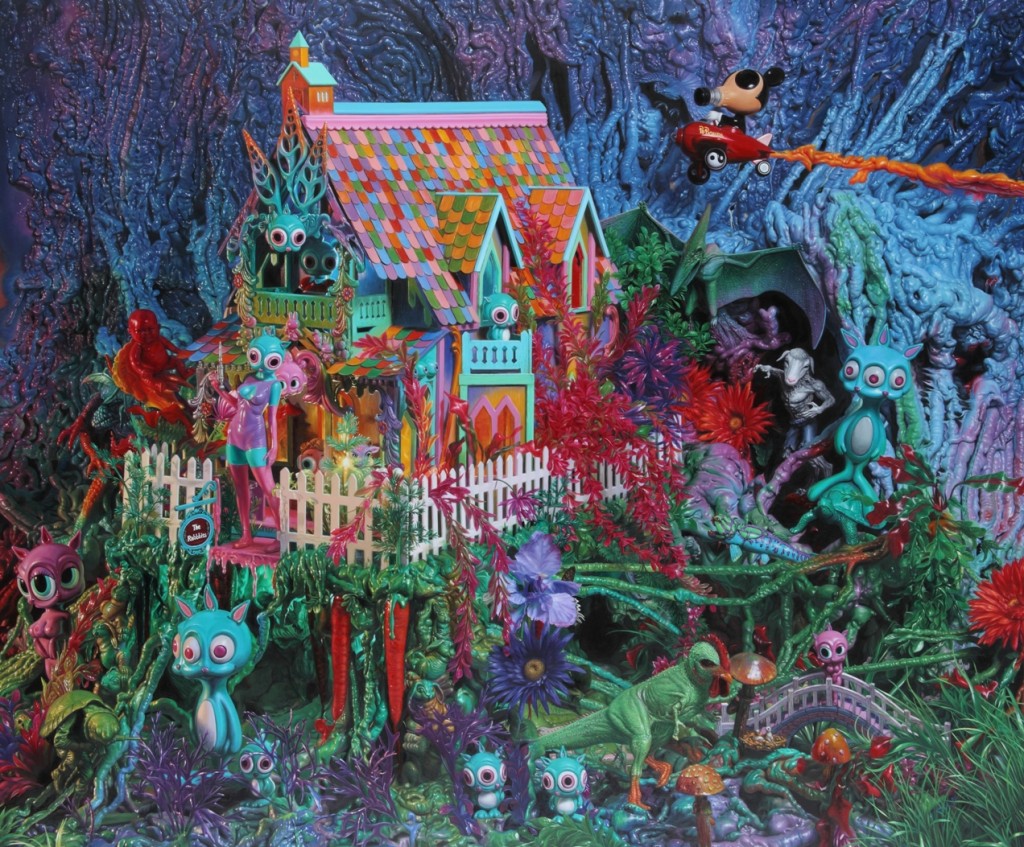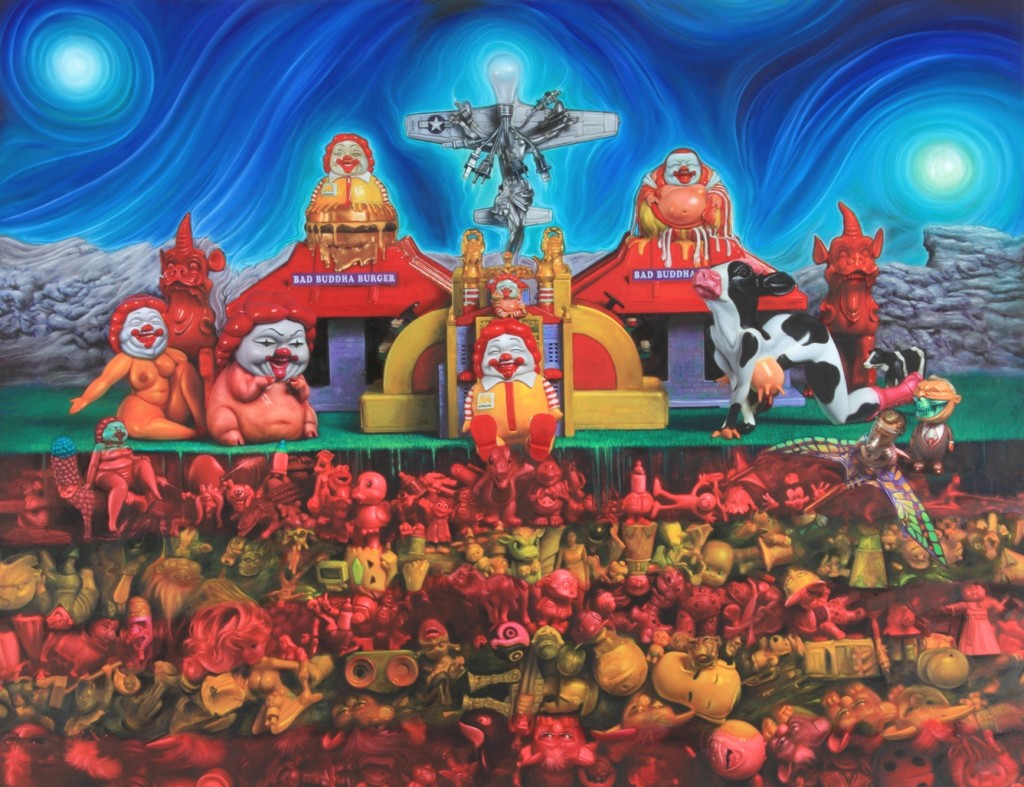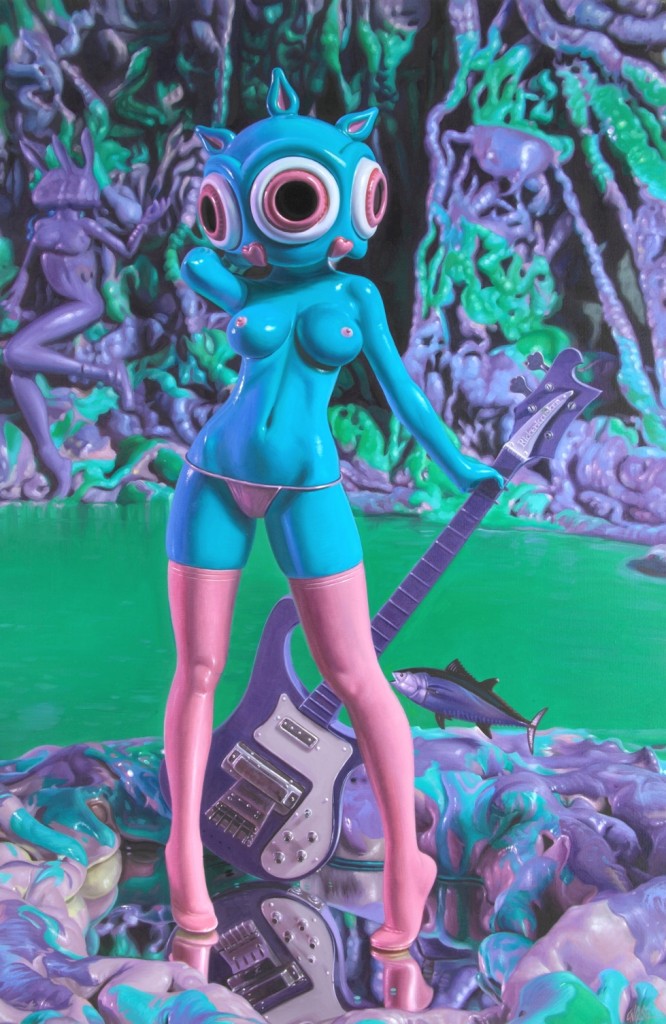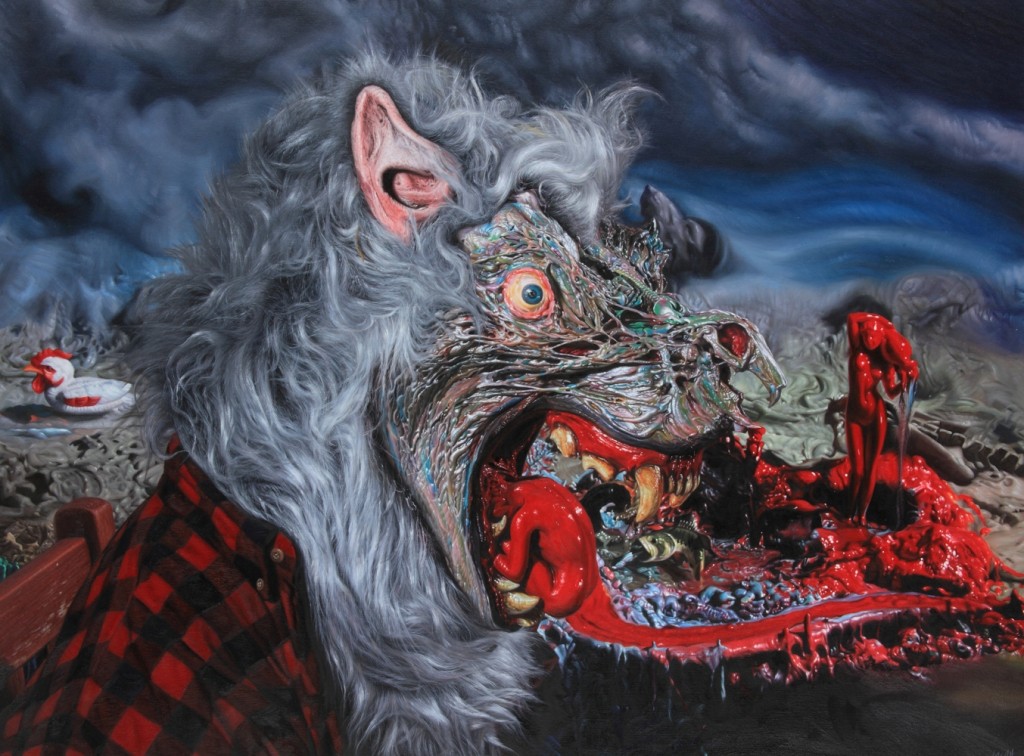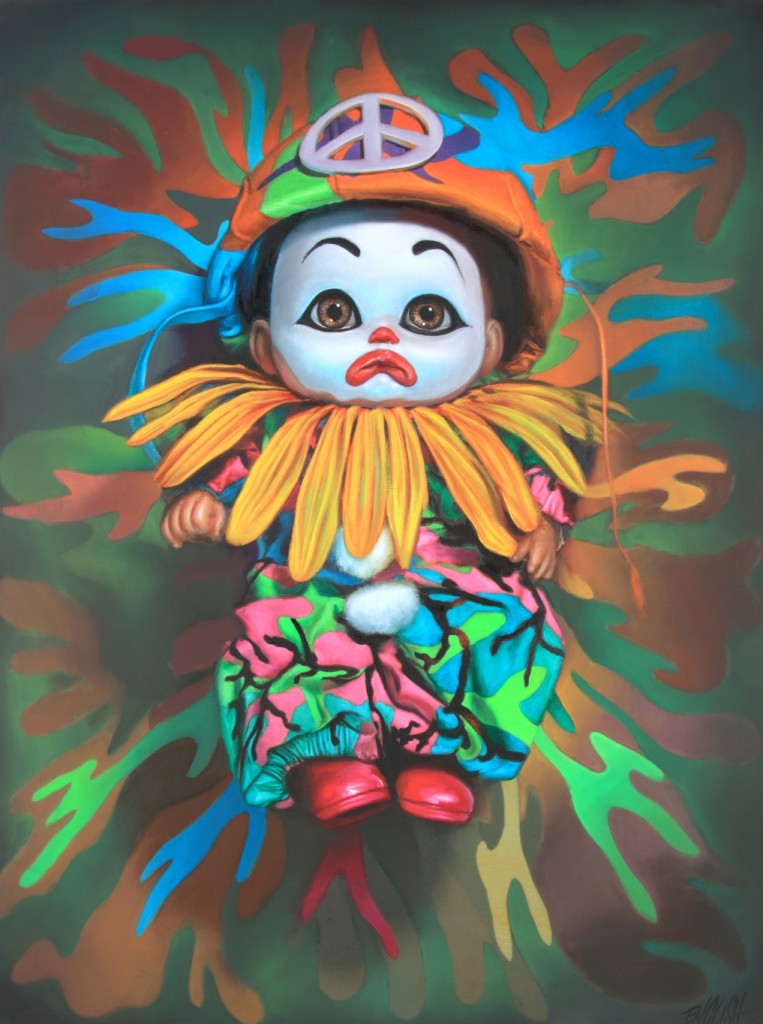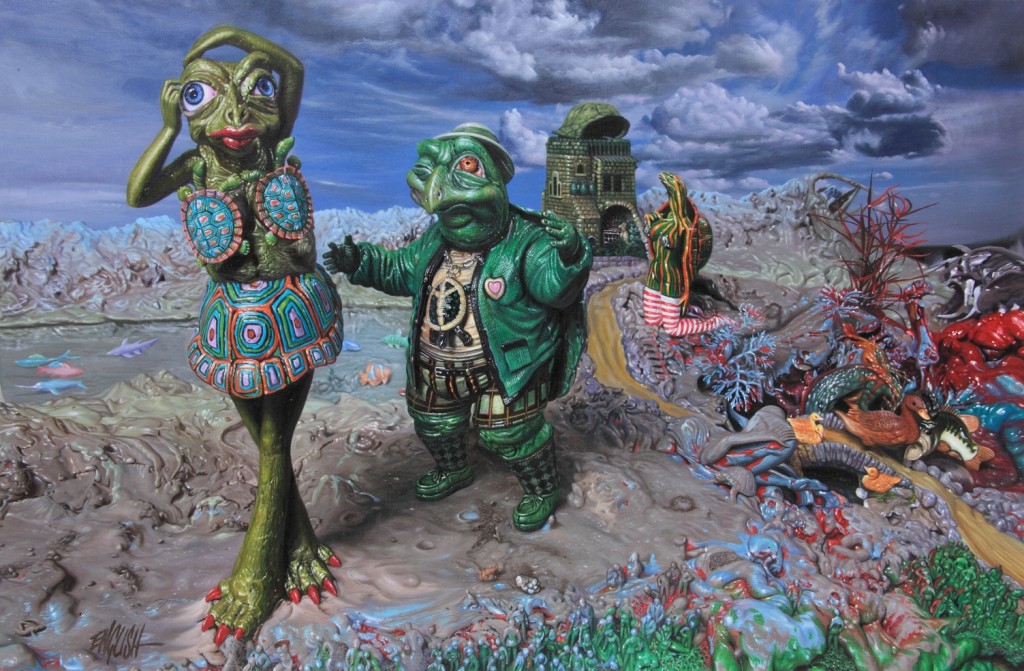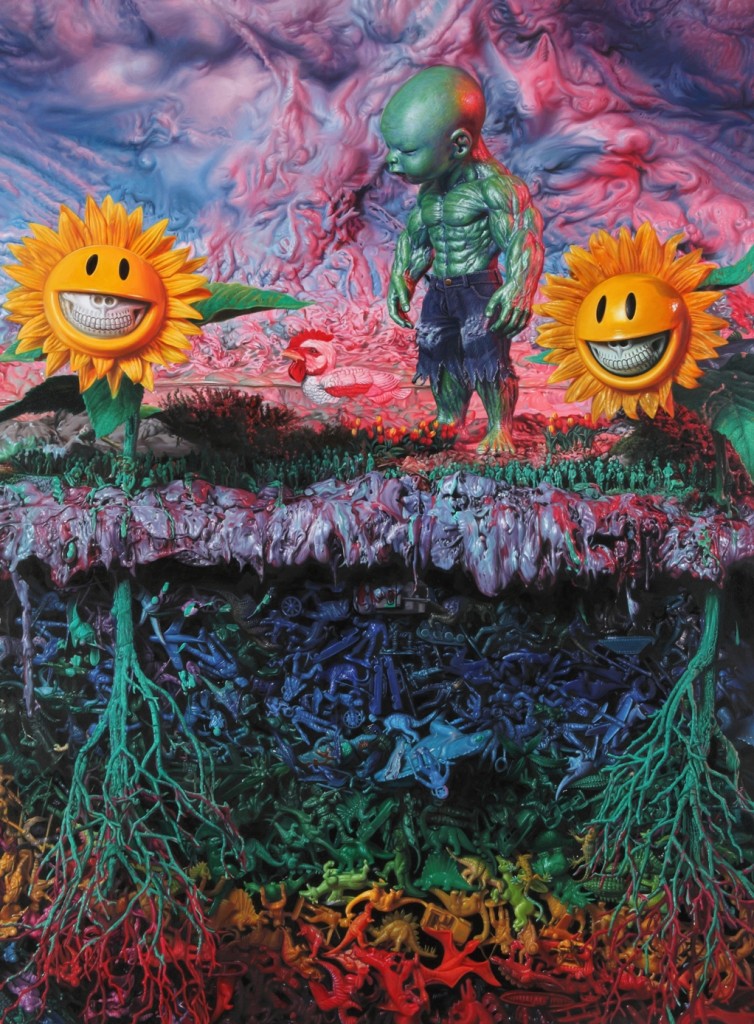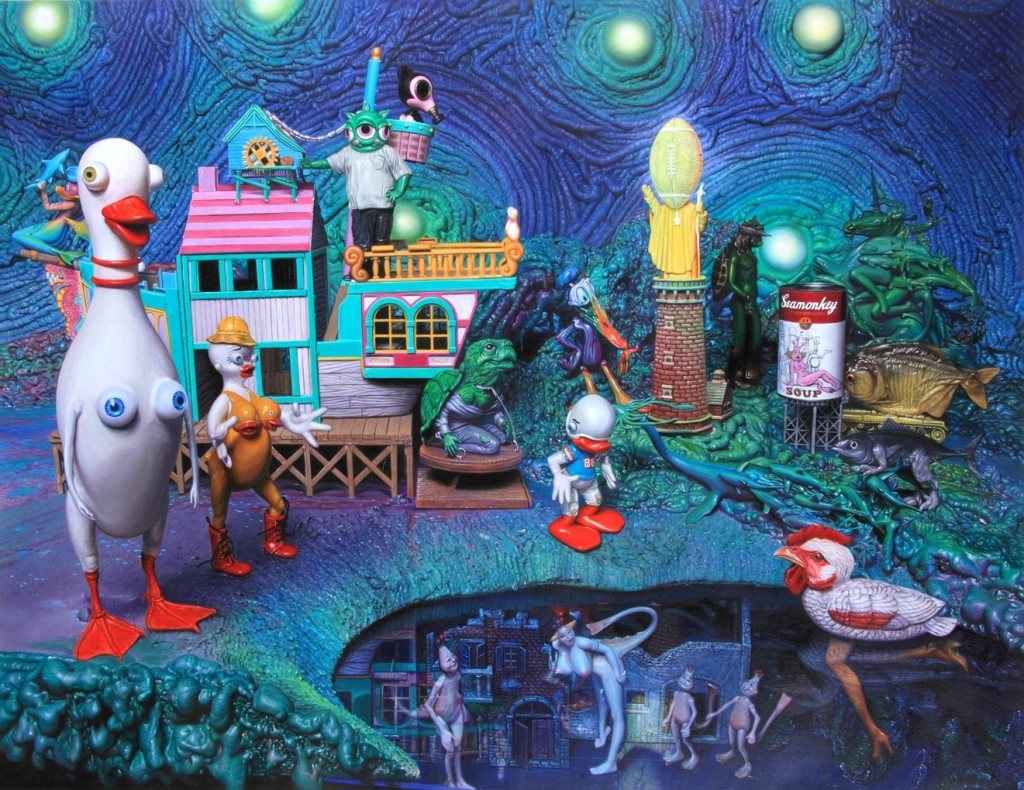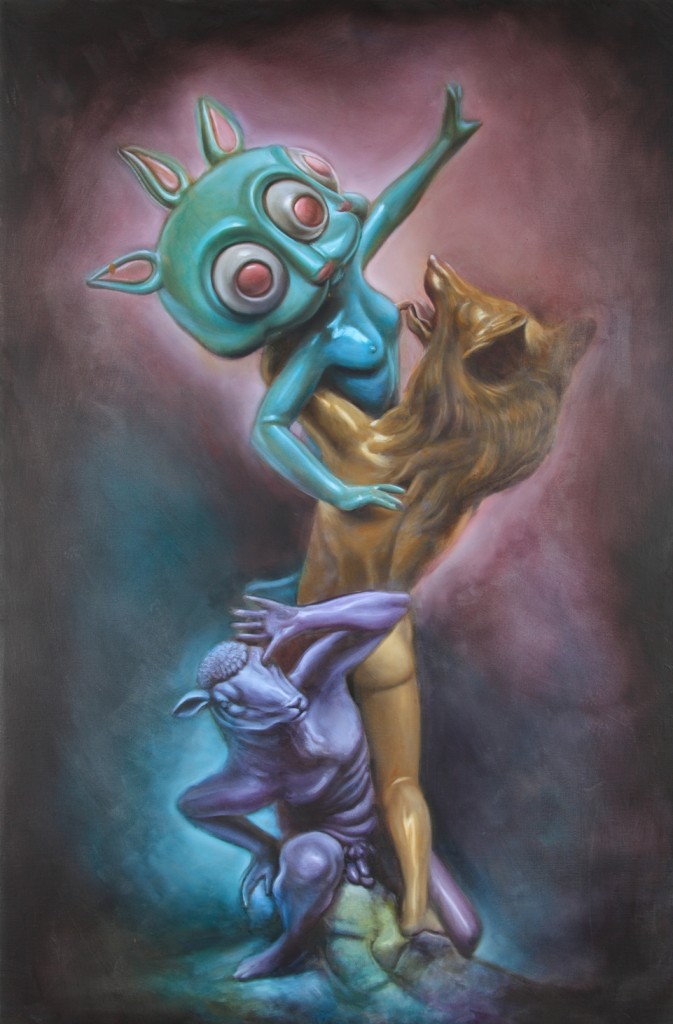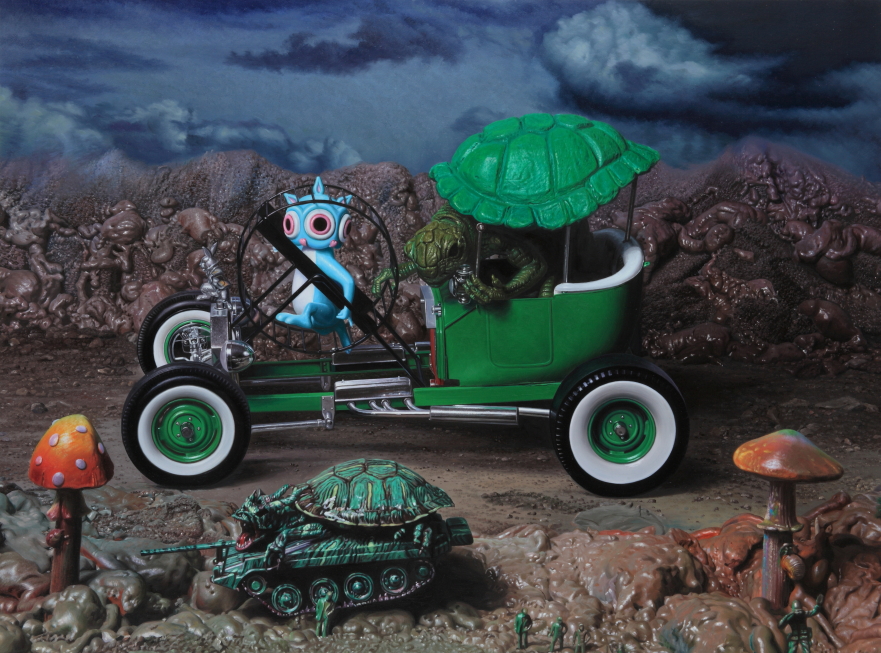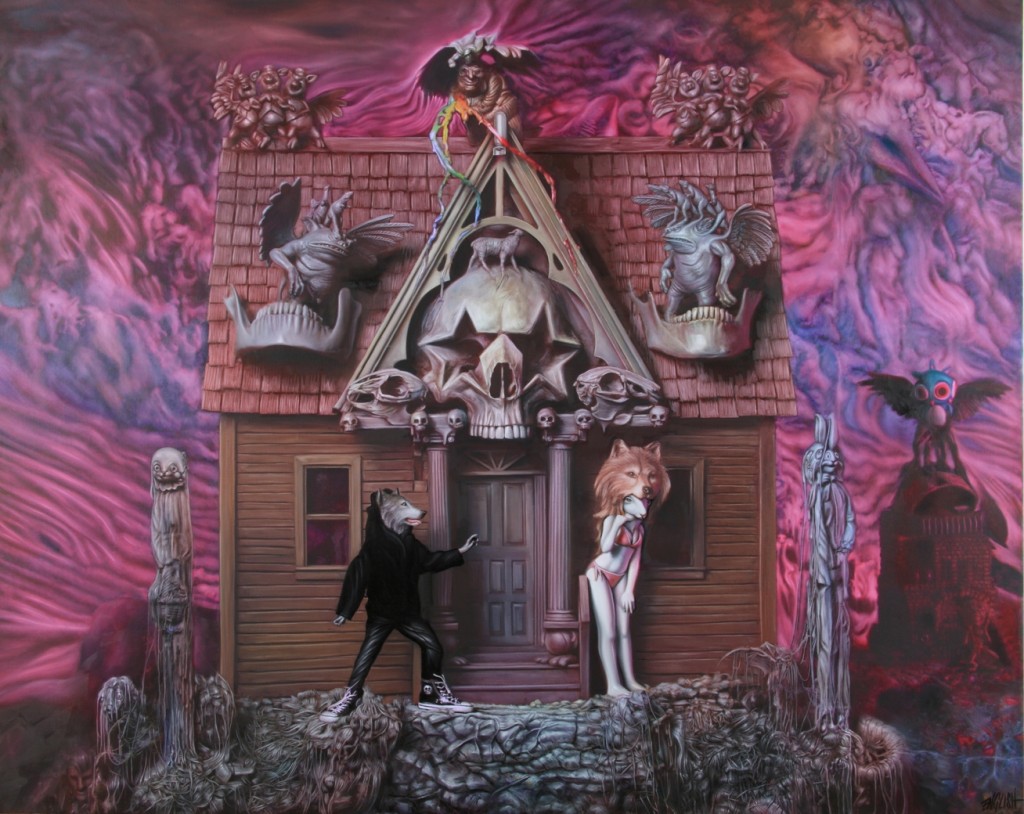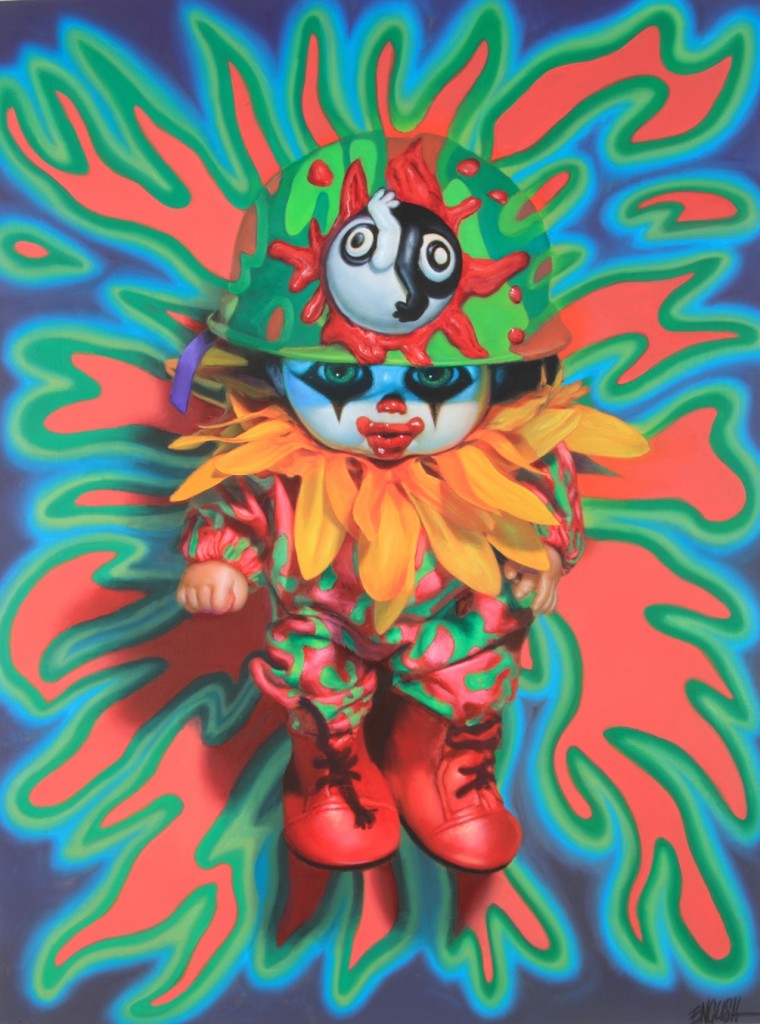Preview: Ron English’s POPagandastan Exhibit @ Corey Helford Gallery [Culver City, Ca]
The master of subversive pop-art surrealism and street art pioneer, Ron English showcases a selection of new mind blowing large scale oil works in Culver City
 I don’t have any idols–as an adult man, that whole concept seems a bit absurd to me–but there are a fair number of individuals that I do have a decent level of admiration for, as it pertains to their respective crafts. Sometimes, I can appreciate their talents. More often, I’m able to appreciate their ability to translate a unique viewpoint, or even their desire to attempt it. When it’s really working and someone discovers how to best harness and direct that talent, that’s when something truly magical and timeless can often be produced. Sometimes, it’s easy enough to simply appreciate the will of an individual, knowing that it was their resilience and mindset to push themselves to whatever levels they have achieved, knowing that might be the only thing that prevents so many others from reaching those levels themselves–that drive can also be considered a gift and a talent in itself. But it is the rare individual that understands themselves so well, has such a clear vision, a strong voice, and possesses such a ridiculous grasp on their medium that they become untouchable, even among the upper echelon in their industry. One such individual is master painter/street art pioneer, Ron English.
I don’t have any idols–as an adult man, that whole concept seems a bit absurd to me–but there are a fair number of individuals that I do have a decent level of admiration for, as it pertains to their respective crafts. Sometimes, I can appreciate their talents. More often, I’m able to appreciate their ability to translate a unique viewpoint, or even their desire to attempt it. When it’s really working and someone discovers how to best harness and direct that talent, that’s when something truly magical and timeless can often be produced. Sometimes, it’s easy enough to simply appreciate the will of an individual, knowing that it was their resilience and mindset to push themselves to whatever levels they have achieved, knowing that might be the only thing that prevents so many others from reaching those levels themselves–that drive can also be considered a gift and a talent in itself. But it is the rare individual that understands themselves so well, has such a clear vision, a strong voice, and possesses such a ridiculous grasp on their medium that they become untouchable, even among the upper echelon in their industry. One such individual is master painter/street art pioneer, Ron English.
English‘s work boggles the fuck out of me, to the point where I can hardly comprehend how it could even exist, let alone how his pieces could be crafted by a human being employing relatively antiquated means. No single artist, currently working today, has managed to pique and sustain my interest in what is occurring in the contemporary art movement, or has blown my mind as wide open to what is possible to accomplish with a simple paintbrush and a healthy does of cynicism, as he has. Ron‘s paintings are almost like mind-tricks… illusions; if you show a large number of them to folks who are less familiar with his work, they’d swear that they were photographs, or digitally produced pieces, at most. I’m familiar with a large catalog of his paintings and have been a fan of his for years, but I still find myself scanning images of his pieces over and over again to verify this, for myself, from time to time. I’ve never had the fortune to view one of his masterworks up close, in person–something that I hope to remedy, at some point– but, those of you in the Southern California area, will have that very opportunity this weekend. English‘s latest solo exhibit, POPagandastan, will be opening this Saturday, October 26th at the Corey Helford Gallery in Culver City. Featuring a number of large-scale new works, and it’s guaranteed to be worth your time.
A really informative new post on his official website, Popaganda.com, titled “Thoughts on the painting process” just appeared yesterday, with English providing some great insight into his approach.
“Thoughts form easily, directed on their seamless journey by stray dialogue or random visual cues, and on rare occasions they trip portals into the deep subconscious and without warning reveal fleeting glimpses of the sublime before morphing back into random trivialities drifting like shadows on clouds. I never know when or from where the potent ones come, but I try to be ready. Once I have an idea I need to get it down on paper before it vanishes as quickly as it appeared. I begin with shorthand sketches which serve as visual reminders, little scribbles I would be embarrassed for anyone to see. For some reason I lose the ability to draw when I am connected to my subconscious. It’s almost like the two sides of my brain switch out at this moment. Once the ideas are saved, I can redo them in a more developed form, either drawn or rendered in clay or other materials.“
And lately, these visions that pop into the artist’s head have become more and more elaborate and chaotic. Employing pop culture imagery as potently as religious iconography, English has done everything from relentlessly appropriating, manipulating, and lampooning influential corporate mascots (Ronald McDonald, Micky Mouse, Joe Camel, etc) to reinterpreting classic artworks (Van Gogh’s Starry Night, Picasso’s Guernica). Over the last 3 decades, he’s also managed to create a plethora of his own reoccurring characters, including his “Telegrinnies,” smiley faces, and Charlie Brown figures, all with their skulls exposed through their over-thetop, chesire grins; his, often erotic, double-faced “rabbbits;” and “Cathy Cowgirl,” with her multi-nippled, udderlike human breasts. English plays heavily off of the juxtaposition of disparate themes, while recycling imagery that involves war, children, peace, clowns, brightly colored camouflage, sperm-like Yin-Yang symbols with muscular biceps, comic books, fast food, Marilyn Monroes with the Mickey Mouse faces for tits, and corporate Amercia in general.
Somehow, maintaining their potency in imagery, his latest paintings find everything swirled into as elaborate of a gumbo as he’s boiled up yet. Meanwhile, it all looks like some sort of crazy hybrid between a surreal world that could never truly exist and a genuine still-life painting (even more accurately, a still-life photograph). Creating something so photo-realistic is a remarkable feat in itself, but is the master painter strictly pulling his uncanny references for lighting, scale, and texture from his memory bank, or is he actually referencing some sort of physical object in front of him? His post goes on to address this question as well.
“During the second part of the process, I am more in the material world. I usually begin by creating three dimensional models, either by sculpting, kit bashing, building sets or finding actual locations. I hold only minimal allegiance to the original vision as I am working, allowing for small discoveries revealed through materials, process or luck. Amorphous imagery is transformed into real life objects that mimic the surreality of the original vision but create a more authentic relationship between the figures and the environment, where impossible perspectives and mythologies become actual yet physically distorted situations.”
At this point, the surreal and the life-like are so blurred that art has begun to imitate itself. English is sculpting figures that reflect older works, which he’s painted, just so that he can paint them again, in new surrealistic landscapes, that he’s actually crafted in physical form. He sculpts and then photographs, just so that he can paint, and those paintings will, undoubtedly, translate back into limited edition figurines, at some point, in the future. His enviable skills as sculptor and photographer are simply part throwaway pieces for him, remaining as just part of his process. Much like how the godfather of lowbrow, Robert Williams, found a strength in his ability to simulate the appearance of chrome like no one else, English has demonstrated a remarkable ability to paint everything from reflections and complex lighting, to textures like fabric, melted wax, plastic, and paper, all within the same image and with an unparalleled grasp on depth and dimensionality.
“My camera is set up to establish a point of view before which the scene is arranged for optimal effect on a flat surface, much like a child’s approach to a blank piece of paper and their uninhibited strategies for filling the page. Perspective is great until it gets in the way of telling the story. I may also set up shop in the natural environment, mixing in my own creations. I find this helpful in deciphering reflections on water with creatures beneath the surface, fire dancing across figures, or a deer’s reaction to Bigfoot.”
Beyond all of the technique employed, the sensory overload, and intricate detail that is naturally embedded into the physical landscapes that he’s created, the thought provoking imagery remains; the subject matter and symbolism still in tact and benefited by the schizophrenic level of images ricocheting off of each other, rather than hindered by it . Look into the clouds, or the melted wax-like landscapes and you’re sure to find plenty of additional figures and subtle references worked in that you might not notice at first glance.
“When everything is ready I take the picture and the photograph serves as the point of departure for the next step in the process. At this stage I may just play photorealist and dutifully copy the photograph with oil paint, or I may find new discoveries in the painting process. This might include internal lighting effects on the figures, abstracting parts of the composition or layering recaptioned comics, reinterpreted product packaging, irrational political posters or truthful advertisements as a background to evolve the central imagery.“
“Each step in the process is an opportunity to enhance the final product, which is usually a lot more intriguing than the original thought in my head and a lot easier to share. And, not unlike children, paintings have a rich life beyond the easel that is beyond your control.”
Ron‘s surreal, photo-realistic (photo-surrealistic?) technique is flawless, making him both immensely inspiring, and one figure that can make an aspiring painter feel like throwing in the towel well before they ever even try to pick up a brush, because his skill level feels so unattainable. Whenever English presents a new collection, I’m always interested, but his prolificity definitely extends beyond the canvas, or even his sculptural work. In fact, he’s even recorded music, both solo and with people like, past Monster Fresh interviewee, Daniel Johnston, but some of his most impassioned work has come through his forays into street art. In the documentary Popaganda: the Art and Crimes of Ron English, you can even hear his wife, Tarssa Yazdani imploring him to focus on canvases, due to the repeated arrests that have been a result of his defacement of public property and attacks on the establishment. Most people might recognize Ron best from his overweight Ronald McDonald parody with the $ chain that he created for the Morgan Spurlock documentary, Supersize Me. Others may have even seen the Abraham Obama image that he first created back during the 2008 presidential election period. Of course, Ron‘s Obama never reached the widespread recognition of something like Shepard Fairey‘s HOPE and CHANGE imagery, or he, the artist that created it, but while friends, contemporaries, and cohorts like Fairey and Banksy have only grown more as public figures in recent years, English‘s work work predates both of theirs and has been as influential as any. Of course, those in the art world are already well aware of Ron English–he’s no slouch devoid of accolades–but the reason that he may not be as prominent a figure and household name, can probably be attributed to the fact that he is much more focused on anti-advertisement, than advertising and marketing himself; he doesn’t have a clothing line and is driven by subverting the system. His early work hijacking billboards to replaster parodies like the “King of Beers/ King of Jews” and Joe Camel with cancer, or to inject Charles Manson into a mock Apple “Think Different” ad, is about as brilliant as anti-corporate street art is going to get–using their own advertising platforms against them. These days he’s been leaving satirical versions of products in actual grocery stores.
Now 30 years into the game, it’s great to see English taking everything that he’s learned and built up to this point, while continuing to push himself in new directions and exploring the territories that he’s already paved, a little deeper. As someone that already respects his work, I’m still paying attention. But for those of you out there who might not be too familiar with the pop art surrealist, hopefully this will open you up to to a world that you never new existed.
Check out a gang of preview images below the following event details…
via press release:
Like an Acid-Pop Aesop’s Fable, these paintings serve as a conceptual battleground for a multitude of viewpoints in harmonic opposition, creating the ultimate Pop Utopia. English has populated his visionary village
with his original characters, each the embodiment of a distinct aspect of the human condition.
The central character is Ronnnie Rabbbit, a three-eyed neurotic rabbit whose two brains argue each side to
every argument. The Combrats are a feral group of doe eyed, runaway, militaristic, dinosaur riding clowns
who enforce community law. The Snappers are slow moving antagonists of a destructive, hyperactive culture of planned obsolescence.The Wolves are resentful, self aggrandizing dethroned inhabitants of a world they once ruled. The sheep are
a cult like tribe that clings to its self-styled spiritual creationism. The Quacks are ambitious, lovable charlatans and creators of quack, the drug that makes you believe anything you think. The Buddha Burgers are a
family of supersized proponents of fast food and unbridled consumerism. The Cowgirls are Mother Nature
personified, embodying an oddly exhilarating combination of fertility, food and sexual desire.
The story of Popagandastan is told through a dizzying kaleidoscope of surrealist imagery composed of the
aspirational iconography and detritus of the TV generation.
WHAT:
POPagandastan
Solo exhibit by Ron English
WHEN:
Opening:
Saturday, October 26th 2013
7pm-10pm
WHERE:
Corey Helford Gallery –
8522 Washington Boulevard
Culver City, CA 90232
Phone: 310-287-2340
ADDITIONAL INFO:
Artist will be in attendance
Show on view until November 16th, 2013
Gallery hours: Tues through Sat. noon – 6pm
[click images to enlarge]
Rabbbit House
(70″ x 60″)
Bad Buddha Building
(56″ x 50″)
Power Ballad Bunnny
(24″ x 36″)
Beau Lief Sheep
(60″ x 30″)
Wolf Profile
(48″ x 36″)
Peace Combrat
(20″ x 26″)
Combrat House
(70″ x 60″)
Mr and Mrs Snapper
(36″ x 24″)
Plastozoic Temper Tot
(36″ x 48″)
Quack House
(46″ x 36″)
Rape of the Leporids
(20″ x 30″)
Tortoise Hare Hotrod
(48″ x 36″)
Wolf House
(56″ x 48″)
Yin Combrat
(20″ x 26.5″)
UPDATE:
Juxtapoz Latino just posted the following video of them visiting Ron English in his studio.
